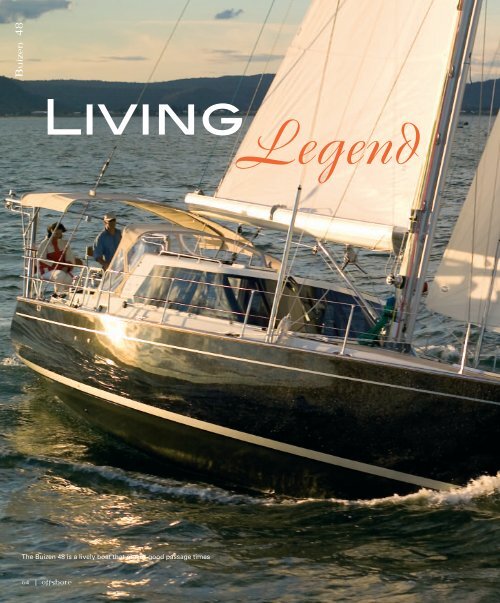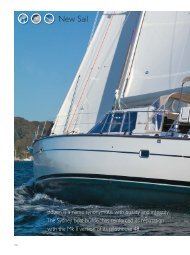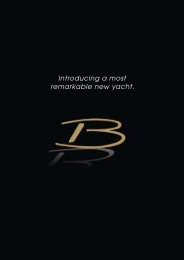reading this article - Buizen Yachts
reading this article - Buizen Yachts
reading this article - Buizen Yachts
Create successful ePaper yourself
Turn your PDF publications into a flip-book with our unique Google optimized e-Paper software.
<strong>Buizen</strong> 48<br />
Living Legend<br />
The <strong>Buizen</strong> 48 is a lively boat that makes good passage times<br />
64 | offshore
The <strong>Buizen</strong> 48, now in Series 3<br />
form, is most people’s idea of<br />
the perfect cruising yacht<br />
By Barry Tranter<br />
Photography Warwick Gibson / bigfish<br />
In a world of hysterical change, the <strong>Buizen</strong> 48 looks much the<br />
same as it always has, though beneath the skin it continues<br />
to evolve. Indeed, the 48 evolves with grace, always moving<br />
forward but never pursuing change for its own sake. Eddy<br />
<strong>Buizen</strong> built the first 48 in 1995 and, 32 boats later, hull and<br />
superstructure are unchanged. But the process of refinement has<br />
been constant.<br />
The <strong>Buizen</strong> 48 is unique, in<br />
Australia at least. Each one<br />
takes 12 months to build and the<br />
company – <strong>Buizen</strong> Pilot House<br />
<strong>Yachts</strong> – builds only three at a<br />
time. The fibreglass is hand-laid,<br />
and the interior and trim are<br />
also done by hand. Each boat<br />
absorbs 10,000 hours of<br />
work and is tailored to the<br />
owner’s requirements.<br />
Three years ago, the Series 2 was introduced, with a new bulbed<br />
keel for a lower centre of gravity. The boat under review in <strong>this</strong><br />
<strong>article</strong> has enough changes incorporated into it to justify being<br />
called the first Series 3.<br />
The <strong>Buizen</strong> 48 is unique, in Australia at least. Each one takes 12<br />
months to build and the company – <strong>Buizen</strong> <strong>Yachts</strong> – builds only<br />
three at a time. The fibreglass is hand-laid, and the interior and trim<br />
are also done by hand. Each boat absorbs 10,000 hours of work and<br />
is tailored to the owner’s requirements. They are cruising yachts and<br />
weigh around 15 tonnes, and though they are not compromised by<br />
the ubiquitous cruiser/racer tag, they sail well.<br />
There are three accommodation layouts available. The boat I saw<br />
offshore | 65
<strong>Buizen</strong> 48<br />
The owner’s cabin and ensuite<br />
The interior is finished in cherry<br />
has the owner’s suite forward (with an island bed and an ensuite head) and<br />
two double cabins aft. Then there’s the ‘family’ layout (including a cabin<br />
with two single bunks) and the ‘passage’ layout, where the owner’s berth<br />
is offset to starboard.<br />
Owners specify variations on these themes, too. Some have one of<br />
the aft guest cabins adapted as an office. The starboard side stern cabin<br />
may become a single when you add a washer-dryer. In fact, the possible<br />
refinements are almost endless. “These are bespoke boats”, says director<br />
Steve Howe. “We act as partners, if you like, with the owners.”<br />
The galley has a big fridge, both top- and front-opening, and a topopening<br />
freezer. They are 240 volts, with a 24-volt motor which kicks in<br />
when you unplug the shore power. The charging system has an auto-start<br />
function when the batteries drop to a certain level of charge. Most of the<br />
boat is 24-volt except for engine start, radios and nav lights. The galley<br />
is two steps down from the saloon (on the level of the cabins) and the<br />
cook passes food up to a serving bench (the dinette is in the pilot house).<br />
For <strong>this</strong> boat, <strong>Buizen</strong> made a unit of a two-burner electric cooktop and a<br />
convection microwave oven with griller. You can, of course, specify gas.<br />
An icemaker is standard. There are two heads, the day head opposite the<br />
galley and the ensuite owner’s head on the port side.<br />
The interior trim is in cherry, though the traditional <strong>Buizen</strong> teak is<br />
also available. The cherry is nicely grained and lighter than teak. The<br />
pilot house is a fine place to be, with 360-degree vision. There’s a dinette<br />
and settee, and to starboard a choice of settee or individual chairs. The<br />
helm position in the pilot house has a throttle control but steering is by<br />
autopilot (there are two, one as backup).<br />
The 48’s engineering profile<br />
is solid. The <strong>Buizen</strong>’s auxiliary is<br />
a Yanmar diesel, with choice of<br />
110hp or 150hp. But considering<br />
that the typical <strong>Buizen</strong> owner<br />
will be a retired (or semi-retired)<br />
couple, probably not in the<br />
first flush of youth, the rig and<br />
hardware have been given a lot of<br />
thought and development.<br />
The boat is rigged as a masthead<br />
sloop but there is a removable<br />
inner forestay so you can add<br />
a jib and storm jib. With the<br />
running backstays (not used<br />
Owners can specify electric<br />
or gas cooktops<br />
66 | offshore
when sailing with the genoa)<br />
the inner forestay steadies the<br />
centre of the mast in a bouncy<br />
sea, when the motion can cause<br />
a mast to pump. Phil Bate rigs<br />
the <strong>Buizen</strong>s, and for <strong>this</strong> boat<br />
he recommended the Leisure<br />
Furl boom furler for the main,<br />
moving away from the usual inmast<br />
furling. The Leisure Furl is<br />
a hydraulic system which makes<br />
raising and lowering sail a painless exercise. Phil has organised a simple<br />
gauge, a fine shock cord led back to the cockpit on the boom’s underside,<br />
which determines the optimal angle for the boom so the sail rolls evenly into<br />
the boom every time, the weak point of many a boom furler. The boom is<br />
locked radially by an hydraulic pin, which fixes a ratchet at the front of the<br />
boom. Open the pin to raise the sail; to lower, the ratchet licks over the pin.<br />
This system enables you to reef the sail to any area you want.<br />
This boat had an Holmatro hydraulic vang, which supports the boom<br />
and stops it bouncing in a seaway. Phil says that the vang enables the<br />
skipper to open the mainsail leech in a seaway in a stiff breeze, which helps<br />
tracking and motion. All these controls are mounted in the cockpit, but<br />
there’s a switch for the furler at the mast base as well.<br />
The headsail winches are big, two-speed, powered Harken #70s. The<br />
smaller winches near the helmsman provide muscle for the main halyard<br />
and boom brake (a standard fitting), mainsheet and headsail furler, a<br />
Reckmann which Phil imports and reckons has a far superior bearing<br />
system which enables him to furl by hand in 12-15 knots of breeze.<br />
Phil has added to the mast, alongside the mainsail track, a separate track<br />
for the storm trysail. He says you can set up the trysail early, in a turtle<br />
at the mast base, sheets on and ready to go, a good idea because when the<br />
going gets rough it is hard enough to hang on, let alone change sails. At<br />
the same time you can set up the storm jib.<br />
The <strong>Buizen</strong> cockpit seems small at first sight but on longer acquaintance<br />
it is the right size, because there is room for enough bodies and handholds<br />
are never far away. The<br />
helmsman’s seat, and two<br />
others, are in the stainless steel<br />
pushpit arrangement right aft.<br />
This boat has a very smart<br />
bimini arrangement; Steve<br />
unzipped and removed the<br />
centre panel for our sail.<br />
The chances of a good sail<br />
looked remote. Sydney in early<br />
winter had a week of glorious<br />
sun and still days after months of mayhem. But the day we set out, the<br />
leaves were stirring and a zephyr was tickling the ears. With Steve and Phil<br />
in charge, we set out onto Pittwater, one of the few places which stays the<br />
same and unspoiled.<br />
Handling the <strong>Buizen</strong> 48 is easy. One squirt on the bow thruster helped<br />
us out of the marina, the 150hp Yanmar did its job, the main went up and<br />
the jib unfurled.<br />
The breeze was moving all over the place. It is was one of those days<br />
when it lifts every time you tack, or it least it did when I was steering. How<br />
does Huey know these things We even threw in a false tack to fool it, but<br />
that only bought us another minute on starboard before it lifted, backed,<br />
gusted and died, all at the same time. Then, as if Huey had decided to take<br />
pity on us, a newborn sea breeze moved in and for a while we had glorious<br />
sailing. The 48 accelerates well when she’s given something to work with,<br />
and suddenly we were seeing six knots-plus over the ground beating into<br />
11-14 knots of nor’easter, but the breeze was is still swinging and aggressive<br />
steering was needed to keep the headsail tufts streaming. The hydraulic<br />
steering was slowish for <strong>this</strong> sort of dinghy sailing, but it’s perfectly geared<br />
for offshore.<br />
Reaching towards home we have 5.3 knots in eight knots apparent, at 90<br />
degrees. The 48 is a lively boat which will make good passage times. Sails<br />
down, engine on, the Yanmar did its work. Both engines (the 110 and 150)<br />
will push the boat up to 9.5 knots, driving through a four-blade stainless<br />
prop. The 110 has a slight advantage in fuel economy, but both units will<br />
The boat is rigged as a masthead sloop<br />
but there is a removable inner forestay<br />
so you can add a jib and storm jib. With<br />
the running backstays (not used when<br />
sailing with the genoa) the inner forestay<br />
steadies the centre of the mast in a<br />
bouncy sea, when the motion can cause<br />
a mast to pump.
fullpa<br />
<strong>Buizen</strong> 48<br />
was done. You know that nothing has been skimped. In the finished<br />
boat, nothing is hidden. You can inspect every aspect of the engineering<br />
because in a hand-built boat, nothing is buried irretrievably behind<br />
mouldings. Confidence comes, too, from the most crass of reasons; you<br />
know <strong>this</strong> boat has not been built to a price. In past decades a phrase like<br />
that has meant that the price could be a shock. But the 48’s starting price<br />
of $1.265 million is no longer shocking because production cruiser/<br />
racers of comparable length easily clear the million mark. For a <strong>Buizen</strong><br />
equipped like <strong>this</strong> one, with watermaker, aircon, GPS/Radar, teak decks,<br />
Bose Audio visual system, the price is around $1.4 million. But it’s<br />
worth a lot to know that your <strong>Buizen</strong> has been built by human hands,<br />
untouched by the robot’s steely claw.<br />
The <strong>Buizen</strong> style of keeping owners closely involved at all stages of<br />
the build of their boat creates<br />
a family atmosphere and is a<br />
welcome respite from these most<br />
impersonal of times.<br />
deliver around one litre per nautical mile.<br />
My emotional reaction is that I would feel confident about<br />
cruising the <strong>Buizen</strong> 48. Part of the reason is that the owner<br />
is invited to be involved in the construction process; you can<br />
watch the hose clamps being screwed home and know how it<br />
The 48 sports a smart bimini<br />
For further information contact<br />
<strong>Buizen</strong> Pilot House <strong>Yachts</strong><br />
Tel:+61(0)2 9450 2170 or visit<br />
www.buizenyachts.com.au<br />
O<br />
On May 22,<br />
the <strong>Buizen</strong> 48<br />
Pilothouse<br />
was named<br />
Australian Boat<br />
of the Year (Sail)<br />
for 2008 by<br />
the Australian<br />
Marine Industry<br />
Federation.<br />
Congratulations<br />
<strong>Buizen</strong>!<br />
Technical specifications<br />
14.6m<br />
12.20m<br />
4.47m<br />
1.85m<br />
15 tonnes<br />
5.5 tonnes<br />
48 sq m<br />
59 sq m<br />
110hp Yanmar<br />
11870 litres<br />
640 litres<br />
From $1,265,000<br />
LOA<br />
WATERLINE LENGTH<br />
BEAM<br />
DRAUGHT<br />
DISPLACEMENT<br />
BALLAST<br />
MAINSAIL<br />
GENOA<br />
ENGINE<br />
FUEL<br />
WATER<br />
PRICE<br />
68 | offshore
The CYCA proudly launches<br />
“From Ratbags to Respectability”<br />
A definitive book on the history of Cruising Yacht Club of Australia<br />
This history of the Cruising Yacht Club of Australia is two stories inextricably<br />
linked. One is of the Club’s struggle from humble beginnings to a position of<br />
prominence in the world of ocean racing. The other is the experience of the<br />
Sydney Hobart Yacht Race and the lessons learned that propelled the club into<br />
the vanguard of safety in ocean racing, where it remains today.<br />
Yours to own today<br />
from $49.95<br />
(CYCA Member Price)<br />
or $59.95 (RRP)<br />
Order your copy today<br />
www.focus.com.au/shop<br />
fullpageadvert4.indd 3<br />
5/7/2008 12:53:02 PM




